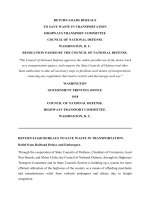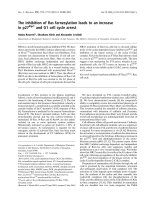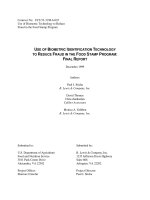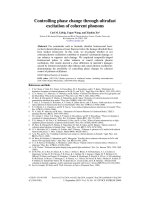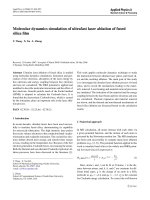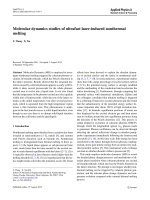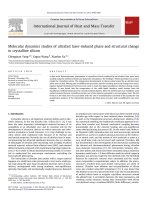coupling of ultrafast laser energy to coherent phonons in bismuth
Bạn đang xem bản rút gọn của tài liệu. Xem và tải ngay bản đầy đủ của tài liệu tại đây (280.03 KB, 3 trang )
Coupling of ultrafast laser energy to coherent phonons in bismuth
Alexander Q. Wu and Xianfan Xu
a͒
School of Mechanical Engineering, Purdue University, West Lafayette, Indiana 47907
͑Received 7 March 2007; accepted 29 May 2007; published online 21 June 2007͒
Energy coupling to coherent phonons in Bi during femtosecond laser–bismuth interaction is
investigated using a double-pulse femtosecond pulse train generated from a temporal pulse shaper.
It is found that the increase of bismuth temperature is dependent on the separation time between the
two laser pulses. Using a numerical fitting, which considers the effect of convolution between the
incident pulses and the material response, the measured temperature increases using different
pulse-to-pulse separations allow quantitative determination of the amount of laser energy coupled
from excited electrons to coherent phonon vibration. © 2007 American Institute of Physics.
͓DOI: 10.1063/1.2750401͔
Since the early 1990’s, many studies have been triggered
by the observation of coherent phonons generated in semi-
metals ͑Bi, Sb͒ and semiconductors ͑Te, Ti
2
O
3
͒.
1–3
The gen-
eration of coherent phonon is attributed to a mechanism
called displacive excitation of coherent phonon,
4–6
which
was shown to be a special case of impulsive stimulated Ra-
man scattering for absorbing materials.
7–9
During the laser
interaction with materials, the laser energy is initially
coupled to electrons, the excited electrons then transfer par-
tial energy to lattice through electron-phonon coupling.
10
In
materials possessing A
1
phonon modes, the excited electrons
will alter the equilibrium position of ions, inducing the ions
to coherently oscillate around the new equilibrium position.
4
Such coherent phonon vibration can be detected by a time-
resolved reflectivity measurement. The large reflectivity
change ⌬R/R ͑10
−3
–10
−2
͒ of coherent phonons generated by
amplified ultrafast laser pulses provides a convenient way for
real-time investigation of phonon dynamics, such as phonon
dephasing due to energy relaxation,
11
phonon softening in-
duced by excited-free electron diffusion and phonon
anharmonicity,
12–18
and atomic displacement.
19
Time-resolved reflectivity measurements can be affected
by many processes: electron excitation and diffusion,
electron-hole recombination, electron-phonon coupling, and
coherent phonon generation. All of these processes except
diffusion will increase the temperature of lattice at surface.
In this work, we perform a double-pulse pump-probe reflec-
tivity experiments to investigate energy coupling during ul-
trafast generation of coherent phonons. Double-pulse trains
are synthesized using a temporal pulse shaper which pro-
duces desired pulse separation and energy of each pulse. By
analyzing the reflectivity signal and evaluating the lattice
temperature rise under different pulse separation conditions,
we quantitatively determine, for the first time the amount of
energy coupled from the excited electrons to coherent pho-
non vibration.
The bismuth film is evaporated on a polished silicon
substrate. The thickness of the bismuth film is around
100 nm, which is much thicker than the absorption depth
͑ϳ15 nm͒ at the 800 and 400 nm laser wavelengths used in
the experiments. We use a standard pump-probe setup to
measure the time-resolved reflectivity. The laser pulses are
produced by a Spectra Physics regenerative amplifier system,
which outputs 100 fs full width at half maximum pulses with
energy up to 1 mJ/pulse at the center wavelength of 800 nm
and a repetition rate of 1 kHz. The pump beam is sent into a
pulse shaper, which generates pulse trains by modulating the
frequency components of the femtosecond laser pulses.
20
The output beam from the pulse shaper passes through a
second harmonic generation crystal to generate the pulse
train at a wavelength of 400 nm. A bandpass filter for wave-
length of 400±20 nm is used to block the residue of 800 nm
laser beam. The collinear 400 nm pump and 800 nm probe
beams are focused on the sample surface by a 100 mm lens
to diameters of 44 and 20
m, respectively. A 100ϫ charge
coupled device imaging system is used to monitor the sample
surface. The reflected beam is measured by a balanced de-
tector and a lock-in amplifier.
Since the detected signal in a pump-probe measurement
is a result of material response convolved with the cross
correlation between pump and probe beams,
21
the effect of
convolution must be considered when the material response
time is comparable to the laser pulsewidth. In our case, the
periodicity of A
1
mode coherent phonon in bismuth is around
0.35 ps, the experimental reflectivity is therefore analyzed
using a numerical procedure considering the effect of convo-
lution. The change in reflectivity caused by coherent phonon
R
p
is expressed as
16
R
p
= A
p
e
−t/t
p
cos͑͑⍀ +

t͒t +
͒, ͑1͒
where A
p
, t
p
, ⍀ ,

,
are coherent phonon amplitude,
dephasing time, angular frequency, chirping coefficient
͑change of phonon frequency with time due to the decay of
excited carriers͒, and initial phase, respectively. The change
of reflectivity due to lattice heating R
l
is approximated as
R
l
= A
l
͑1−e
−t/t
l
͒, ͑2͒
where A
l
and t
l
are the maximum of lattice heating and its
time constant, respectively. The response of electrons R
e
is
modeled as
R
e
= A
e1
e
−t/t
e1
+ A
e2
e
−t/t
e2
, ͑3͒
where A
e1
, A
e2
, and t
e1
, t
e2
, are the peak amplitudes and
decay times, respectively. It was noted that two exponential
terms fitted the experimental data better than one term ap-
proximation did. The total response of the system is a con-
a͒
Author to whom correspondence should be addressed; electronic mail:
APPLIED PHYSICS LETTERS 90, 251111 ͑2007͒
0003-6951/2007/90͑25͒/251111/3/$23.00 © 2007 American Institute of Physics90, 251111-1
Downloaded 25 Jun 2007 to 128.46.184.20. Redistribution subject to AIP license or copyright, see />volution between R=͑R
p
+R
l
+R
e
͒U͑t͒ and the pulse input
͑which can be double pulses, as described below͒, where
U͑t͒ is a unit step function.
Double pulses have been used to control coherent pho-
non vibration.
22
In this work, we control the separation time
and energy of each pulse to enhance or completely cancel
phonon vibrations. The difference in lattice temperature rise
with and without coherent phonon vibration is then analyzed
to determine energy coupling to coherent phonons. Figure 1
shows measured time-resolved reflectivity change ⌬R /R
pumped by a double-pulse train with ͑a͒ ⌬t =0.711 ps which
is intended to enhance phonon oscillation, and ͑b͒ ⌬t
=0.535 ps which is intended to cancel phonon oscillation.
The ratio of the intensities of the two pulses is 1.00:0.61,
which was found from experiments to completely cancel
phonon oscillation. The 400 nm double-pulse pump has a
total fluence F =0.69 mJ/cm
2
, and the 800 nm probe pulse
has a fluence F=0.03 mJ/cm
2
. The inset shows a shorter
time period as well as the cross correlation between the
pump and the probe beams. It is seen that with a separated
time ⌬t =0.711 ps, the third peak of coherent phonon oscil-
lation corresponds to the end of the second laser pulse, and
its amplitude is enhanced. With a separated time
⌬t =0.535 ps, phonon vibration after the second peak is can-
celed completely. Note that at longer time when the system is
approaching electron-lattice equilibrium, the reflectivity is
less than the value before t =0 due to lattice heating. This
negative temperature dependence of reflectivity is verified by
the measurement of temperature dependence of reflectivity.
The amplitude of phonon vibration is apparently stronger
than those reported in literature ͑e.g., Ref. 15͒ which were all
obtained using 800 nm pump beam. Our own experiments
also confirmed that the phonon amplitude excited by 800 nm
pump beam is much weaker. Figure 1 also shows that results
of numerical fitting using Eqs. ͑1͒–͑3͒ are in excellent agree-
ment with the experimental data, which allow quantitative
analysis which is to be described below. The parameters fit-
ted from the experimental data are summarized in Table I.
Figure 2͑a͒ shows the difference in reflectivity change,
DR=⌬R /R
͑⌬t=0.535 ps͒
−⌬R /R
͑⌬t=0.711 ps͒
, and the extracted
reflectivity change −͑⌬R /R͒
p
caused by coherent phonon
only for ⌬t=0.711 ps. The inset in Fig. 2͑a͒ shows the result
for a longer time, up to 18 ps. Figure 2͑b͒ shows the first few
picoseconds of DR and the difference in the cross correlation
measurements DG=G
͑⌬t=0.535 ps͒
−G
͑⌬t=0.711 ps͒
, where
FIG. 1. ͑Color online͒ Time-resolved reflectivity of Bi film pumped by a
double-pulse train with different separation times of ͑a͒ 0.711 ps and ͑b͒
0.535 ps.
TABLE I. Parameters fitted from the experimental data.
A
p
͑10
−3
͒
t
p
͑ps͒
⍀/2
͑THz͒

͑rad/ps
2
͒
͑deg͒
A
e1
͑10
−3
͒
t
e1
͑ps͒
A
e1
͑10
−3
͒
t
e2
͑ps͒
A
l
͑10
−3
͒
t
l
͑ps͒
Cancellation 5.74 1.17 2.76 0.155 −87.7 1.98 0.42 2.26 3.42 −3.57 55
Enhancement 6.05 1.14 2.72 0.153 −94.3 1.86 0.46 1.91 2.94 −2.50 21
FIG. 2. ͑Color online͒ Time dependence of ͑a͒ difference in reflectivity
change DR
͑t͒
=⌬R /R
͑⌬t=0.535 ps͒
−⌬R /R
͑⌬t=0.711 ps͒
͑black͒ and
−⌬R/R
͑t,⌬t=0.711 ps͒
due to the coherent phonon only ͑red͒, and ͑b͒ difference
in cross correlation DG
͑t͒
=G
͑⌬t=0.535 ps͒
−G
͑⌬t=0.711 ps͒
. The cross correlations
G
͑⌬t=0.535 ps͒
and G
͑⌬t=0.711 ps͒
are also shown in ͑b͒.
251111-2 A. Q. Wu and X. Xu Appl. Phys. Lett. 90, 251111 ͑2007͒
Downloaded 25 Jun 2007 to 128.46.184.20. Redistribution subject to AIP license or copyright, see />G
͑⌬t=0.535 ps͒
and G
͑⌬t=0.711 ps͒
are cross correlations measured
at pulse separation of 0.535 and 0.711 ps, respectively,
which are also shown in Fig. 2͑b͒. The difference in reflec-
tivity change DR can be considered as the signal generated
by a virtual double-pulse train represented by DG. At time
tϽ 0.25 ps, both DR and DG are around 0 as they are deter-
mined by the difference in the first pulse in the double-pulse
train, which are identical for the two cases at tϽ0.25 ps. At
time tϾ0.8 ps, around the end of the virtual double-pulse
train, DR is dominated by a oscillatory component, which is
almost the same as −⌬R /R
͑⌬t=0.711 ps͒
since the phonon oscil-
lation for ⌬t =0.535 ps is completely canceled. The most rel-
evant feature for our analysis in DR is that, at time t Ͼ8 ps,
the oscillation is attenuated significantly, and DR approaches
a value of 6.5ϫ 10
−4
, which reflects lattice heating caused by
enhanced coherent phonon vibration by the second pulse for
⌬t =0.711 ps.
The positive value of DR shows that more energy is
extracted from excited carriers by coherent phonon vibration
and is then transferred to lattice heating. This also indicates
that energy transfer from coherent phonon to the lattice heat-
ing is a faster process compared with lattice heating by ex-
cited carriers directly due to the fast dephasing time of co-
herent phonons. The value of DR can be analyzed to
determine quantitatively the energy coupling from the ex-
cited carriers to coherent phonons. The coherent phonon vi-
bration can be seen as harmonic oscillation with energy pro-
portional to the square amplitude of reflectivity change
͑⌬R /R͒
p
2
. For ⌬t=0.711 ps, the amplitude of the first peak of
reflectivity change caused by the coherent phonon is −1.33
ϫ10
−2
at t=0.08 ps ͓note Fig. 2͑a͒ shows −͑⌬R/R͒
p
͔. From
numerical fitting, the third negative peak of phonon vibration
would have decayed to an amplitude of −5.91ϫ 10
−3
at
t=0.80 ps if there were no second pumping pulse. With the
second pumping pulse, Fig. 2͑a͒ shows that the amplitude of
the third negative peak at t=0.80 ps is −1.38ϫ10
−2
,sothe
contribution from the second pumping pulse in the third peak
is 82% ͑1−0.591
2
/1.38
2
͒.
In order to relate coherent phonon vibration to lattice
heating, the static temperature dependence of reflectivity
change was measured independently by heating the sample
with a patch heater and recording the reflectivity change. It is
found that when the temperature increase is less than 95 °C,
the reflectivity change decreases linearly with temperature as
d͑⌬R/R͒ /dT=−8ϫ 10
−5
/ °C. As shown in Fig. 1, values of
⌬R /R for both cases of ⌬t =0.535 and 0.711 ps are less than
6ϫ 10
−3
, implying that the temperature increases are less
than 75 °C, within the linear range of reflectivity change.
The difference of the temperature ͑reflectivity͒ increase at
tϾ 8 ps in Fig. 2͑a͒, which is caused by the difference
between with and without coherent phonon vibration at the
end of second pumping pulse, can be calculated from
DR/͑d͑⌬R /R͒ /dT͒. The energy needed for generating
such a difference in temperature increase is ⌬F
=
cdDR/͑d͑⌬R /R͒ /dT͒, where
, c, d are density, heat ca-
pacity, and absorption depth of bismuth for the wavelength
of the pumping laser, respectively. Using d͑⌬R /R͒/dT
=−8ϫ10
−5
/K and d =15 nm, the laser energy ⌬F is found to
be 0.014 mJ/cm
2
. As mentioned before, 82% of the total
energy of the coherent phonon at t=0.80 ps is from the sec-
ond pulse which has a laser fluence of 0.26 mJ/cm
2
, there-
fore the energy coupled to coherent phonon vibration ac-
counts for about 4.4% ͑0.82ϫ0.014/0.26͒ of the energy of
the second laser pulses.
In summary, we reported time-resolved reflectivity of
bismuth pumped by a double-pulse train. The experimental
data were analyzed by a numerical fitting which considered
the effect of convolution on the experimental data. It was
found that energy can be coupled from excited carriers to
lattice heating by the generation of coherent phonon vibra-
tion. The increase in lattice temperature shortly after the laser
pulses depends on the separation time between the two
pumping pulses. The difference of temperature increase with
enhanced and canceled phonon vibration was used to quan-
titatively estimate energy coupling from excited carriers to
coherent phonons.
Support to this work by the National Science Foundation
is acknowledged.
1
T. K. Cheng, S. D. Brorson, A. S. Kazeroonian, J. S. Moodera, G.
Dresselhaus, M. S. Dresselhaus, and E. P. Ippen, Appl. Phys. Lett. 57,
1004 ͑1990͒.
2
T. K. Cheng, J. Vidal, H. J. Zeiger, G. Dresselhaus, M. S. Dresselhaus, and
E. P. Ippen, Appl. Phys. Lett. 59, 1923 ͑1991͒.
3
H. J. Zeiger, T. K. Cheng, E. P. Ippen, J. Vidal, G. Dresselhaus, and M. S.
Dresselhaus, Phys. Rev. B 54, 105 ͑1996͒.
4
H. J. Zeiger, J. Vidal, T. K. Cheng, E. P. Ippen, G. Dresselhaus, and M. S.
Dresselhaus, Phys. Rev. B 45, 768 ͑1992͒.
5
S. Hunsche and H. Kurz, Appl. Phys. A: Mater. Sci. Process. 65,221
͑1997͒.
6
K. S. Tinten, C. Blome, J. Blums, A. Cavalleri, C. Dietrich, A.
Tarasevitch, I. Uschmann, E. Forster, M. Kammler, M. Horn-von-Hoegen,
and D. Linde, Nature ͑London͒ 422, 287 ͑2003͒.
7
G. A. Garrett, T. F. Albrecht, J. F. Whitaker, and R. Merlin, Phys. Rev.
Lett. 77,3661͑1996͒.
8
R. Merlin, Solid State Commun. 102, 207 ͑1997͒.
9
T. E. Stevens, J. Kuhl, and R. Merlin, Phys. Rev. B 65, 144304 ͑2002͒.
10
A. Q. Wu, I. H. Chowdhury, and X. Xu, Phys. Rev. B 72, 085128 ͑2005͒.
11
M. Hase, K. Mizoguchi, H. Harima, S. Nakashima, and K. Sakai,
Phys. Rev. B 58, 5448 ͑1998͒.
12
S. Hunsche, K. Wienecke, T. Dekorsy, and H. Kurz, Phys. Rev. Lett. 75,
1815 ͑1995͒.
13
P. Tangney and S. Fahy, Phys. Rev. Lett. 82, 4340 ͑1999͒.
14
P. Tangney and S. Fahy, Phys. Rev. B 65, 054302 ͑2002͒.
15
M. Hase, M. Kitajima, S. Nakashima, and K. Mizoguchi, Phys. Rev. Lett.
88, 067401 ͑2002͒.
16
V. Misochko, M. Hase, K. Ishioka, and M. Kitajima, Phys. Rev. Lett. 92,
197401 ͑2004͒.
17
S. Fahy and D. A. Reis, Phys. Rev. Lett. 93, 109701 ͑2004͒.
18
É. D. Murray, D. M. Fritz, J. K. Wahlstrand, S. Fahy, and D. A. Reis,
Phys. Rev. B 72, 060301 ͑2005͒.
19
M. F. DeCamp, D. A. Reis, P. H. Bucksbaum, and R. Merlin, Phys. Rev. B
64, 092301 ͑2001͒.
20
A. M. Weiner, Rev. Sci. Instrum. 71, 1929 ͑2000͒, and references therein.
21
Á. Bányásza, E. Mátyusa, and E. Keszei, Radiat. Phys. Chem. 72,235
͑2005͒.
22
M. Hase, K. Mizoguchi, H. Harima, S. Nakashima, M. Tani, K. Sakai, and
M. Hangyo, Appl. Phys. Lett. 69, 2474 ͑1996͒.
251111-3 A. Q. Wu and X. Xu Appl. Phys. Lett. 90, 251111 ͑2007͒
Downloaded 25 Jun 2007 to 128.46.184.20. Redistribution subject to AIP license or copyright, see />


